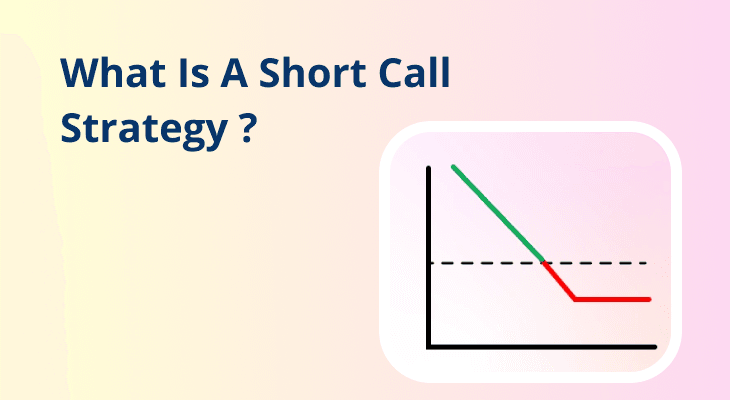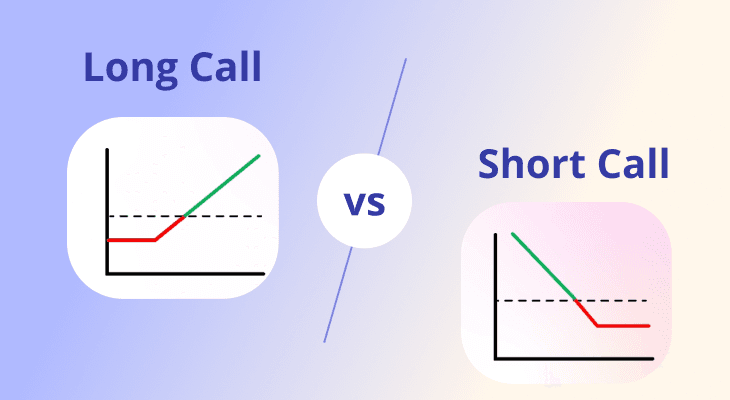
What Is A Short Call Strategy?
In options trading, strategies vary based on how the market is expected to move. One such strategy is the short call which is used when traders expect limited upward movement or a decline in a stock’s price. Unlike long calls that benefit from price rises, a short call can generate profit even when prices stay stagnant or fall. While the premium received provides limited profit potential, the risk can be significantly high if the stock price surges. This makes understanding the mechanism, risks, and use cases of short calls extremely important before including them in any trading strategy.
This article explores how the short call strategy works, its payoff structure, and how experienced traders use it to generate returns, along with risks and key points to remember before using it.
What Is A Short Call Strategy?
The short call strategy is an advanced options trading approach used when a trader has a bearish view on the underlying asset. In simple terms, it involves selling a call option without owning the underlying stock. The goal here is to profit from the premium received when the stock price is expected to stay below the strike price until the option expires.
When you initiate a short call, you’re taking on the obligation to sell the underlying asset at the agreed strike price if the buyer chooses to exercise the option. In exchange, you receive a premium upfront. This premium becomes your maximum possible profit, but if the stock price rises significantly, your losses can be unlimited because you may be forced to sell the stock at a much lower price than the market value.
It’s worth mentioning that this strategy may not be suitable for beginners due to the high risk potential. However, with proper risk controls, experienced traders can use it in range-bound or bearish markets.
How Does A Short Call Work?
To understand how a short call works, let’s walk through a simple example.
Example:
- Underlying Stock: ABC Ltd.
- Current Market Price: ₹90
- Strike Price of the Call Sold: ₹100
- Premium Received: ₹5
- Contract Size: 100 shares
You believe that ABC Ltd.’s price will not rise above ₹100 in the near term. So, you sell a call option with a strike price of ₹100 and receive ₹5 per share as premium (₹500 total for the lot).
Now, what happens on expiry?
Stock Price at Expiry | Call Option Outcome | Net Profit/Loss |
|---|---|---|
Below ₹ 100 | Expires as worthless | +₹ 500 (premium) |
₹ 105 | Breakeven | ₹ 0 |
Above ₹ 105 | Exercised, losses begin | -₹ X (where X is the rise in the stock price above the strike price) |
Scenario 1: Stock stays below ₹ 100 (say ₹ 95)
The option expires as worthless. The buyer won’t exercise the right to buy at ₹ 100 when the market price is ₹ 95.
Your Profit = ₹ 500 (premium received)
Scenario 2: Stock closes at ₹ 105
The buyer exercises the option. You are obligated to sell at ₹ 100, while the market price is ₹ 105. You incur a loss of ₹ 5 per share, but since you received ₹ 5 as premium, your net payoff is zero.
Break-even Point = ₹ 105 (Strike price + Premium received)
Scenario 3: Stock goes to ₹ 120
Now your loss is much higher. You must sell the stock at ₹ 100, but its market price is ₹ 120. That’s a loss of ₹ 20 per share, while you only received ₹ 5 in premium.
Net Loss = ₹ 15 × 100 = ₹ 1,500
Payoff Chart & Maximum Loss/Profit
Understanding the payoff structure is crucial in a short call.
Maximum Profit
- Limited to the premium received when selling the call.
- In our example: ₹5 × 100 = ₹500
Maximum Loss
- Theoretically unlimited, because the stock price can rise indefinitely, and you’re still obligated to sell at the strike price.
Benefits Of A Short Call Strategy
While risky, a short call strategy offers certain advantages when used cautiously.
- Income Generation in Sideways Markets: If the market is range-bound or slightly bearish, selling calls can generate regular income from the premiums.
- Probability of Profit is Higher: Since the stock price must rise above the strike price + premium to cause a loss, the chance of making at least some profit is statistically higher than in long options.
- Time Decay Works in Your Favour: Options lose value as they near expiration. As a seller, theta decay benefits you since the value of the option drops, increasing your chances of keeping the premium.
- Useful in Neutral to Bearish Views: When you are confident that the price of a stock or index will not rise, a short call can help you monetise that expectation.
When To Use A Short Call Strategy?
Short calls are suitable for specific trading environments and objectives:
- Bearish to Neutral Outlook: Best used when you expect the stock price to fall or remain flat.
- Range-Bound Markets: If a stock is stuck within a narrow range, selling out-of-the-money calls can be profitable.
- Capitalizing on Time Decay: Ideal when expiry is near, and you expect minimal price movement.
Example Situations:
- A stock has just rallied significantly and is showing signs of consolidation or reversal.
- Major event-driven volatility has passed, and implied volatility remains high, making premiums expensive.
- The resistance level is strong, and technical indicators show limited upside.
Risks and Considerations
While the short call strategy can offer consistent income, it carries risks that must be understood:
- Unlimited Loss Potential: If the market moves against you, losses can grow quickly. Unlike long options where losses are limited to premiums paid, short calls carry uncapped risk.
- Margin Requirement: Since this is a naked position (not backed by actual stock), brokers require higher margins. Sudden price spikes can result in margin calls.
- Requires Close Monitoring: This strategy cannot be set and forgotten. Prices can move sharply due to news, earnings, or global events, requiring fast decision-making.
- Volatility Risk: High implied volatility can inflate option premiums, and if volatility increases post-entry, the position can move against you even if price doesn't change much.
- Early Assignment Risk: If the call is in-the-money and the buyer chooses to exercise it early, you could be forced into delivery.
Conclusion
The short call strategy is a powerful tool in an experienced trader’s arsenal. While it allows for income generation in flat or bearish markets, it comes with unlimited downside risks and requires active monitoring and discipline. It’s not ideal for beginner traders, especially those unfamiliar with margin calls, volatility management, or position sizing.
If you're considering short calls, start with paper trading or use covered calls (where you already hold the stock) to mitigate risk while learning the strategy mechanics. A clear understanding of market outlook, technical levels, and risk management is essential for success.
Additional Read: Options Trading for Beginners: A Comprehensive Step-by-Step Guide
FAQ
What does a short call mean in options trading?
A short call refers to selling a call option without owning the underlying stock. The trader collects a premium upfront and is obligated to sell the stock at the strike price if the option is exercised. This strategy benefits from price stagnation or decline but carries unlimited risk if the stock price rises significantly.
When should traders consider using a short call strategy?
A short call is ideal when the trader has a bearish or neutral view of the underlying asset. It’s commonly used when expecting little or no price movement. This strategy works best in range-bound markets where the stock is unlikely to breach the strike price before expiry.
How do you make a profit from a short call option?
Profit in a short call comes from the premium received when selling the call option. If the stock price stays below the strike price until expiry, the option loses all its value and expires, and the trader keeps the premium. This premium becomes the maximum potential profit in the short call strategy.
What are the risks involved in a short call trade?
The short call strategy involves unlimited risk because if the stock price rises significantly, the seller might have to sell the stock at the lower strike price, incurring huge losses. Since the trader doesn’t own the stock, they may be forced to purchase it at a high market price to settle the contract.
What is the payoff structure of a short call strategy?
The short call payoff is asymmetrical. The maximum profit is limited to the premium received, but the losses can be unlimited if the stock price surges. The breakeven point is the strike price plus the premium earned. Any price above that causes a loss, increasing with each point rise in the stock.
Is margin required to initiate a short call position?
Yes, selling a call option requires a margin deposit because of the potentially high risk. Brokers usually demand a margin amount based on the volatility of the stock, time to expiry, and the strike price. This ensures the trader can cover potential losses if the trade moves against them.
Can beginners try the short call strategy?
This strategy is not recommended for beginners due to its complex nature and unlimited loss potential. New traders may lack the risk control mechanisms needed to manage large market movements. It's more suited to experienced traders who understand options pricing, volatility, and hedging techniques.
How is a short call different from a long call?
A long call gives the buyer the right to buy stock at a strike price and profits from a price increase. A short call, in contrast, sells this right to someone else and profits if the price stays below the strike. The long call has limited risk; the short call has unlimited risk.
What happens if a short call expires in the money?
If a short call expires in the money, the trader is obligated to deliver the stock at the strike price, even if it’s trading higher in the market. This results in a loss, which grows the higher the market price goes above the strike price. It’s the biggest risk of this strategy.
Can a short call be combined with other strategies?
Yes, the short call is often used in combination with other strategies to manage risk. For example, in a covered call, the trader sells a call while owning the stock, limiting downside. Similarly, short calls can be part of bear call spreads or iron condors to balance risk and reward.


